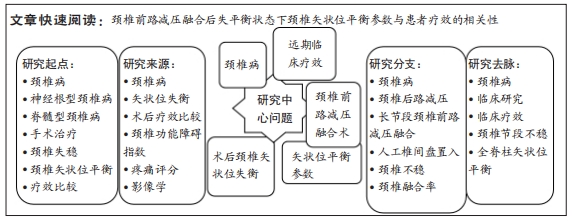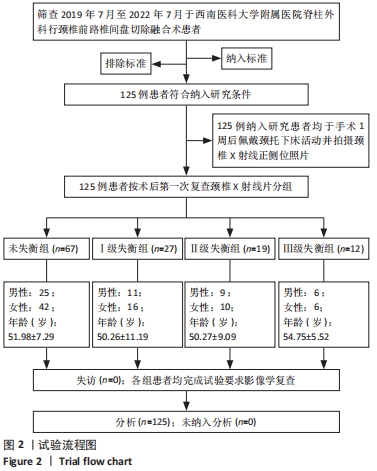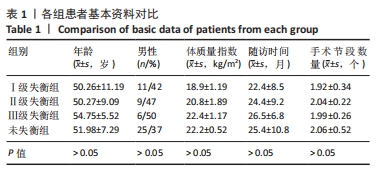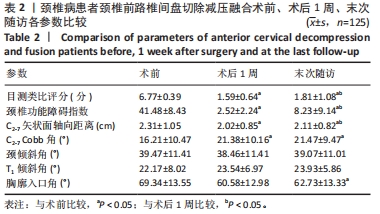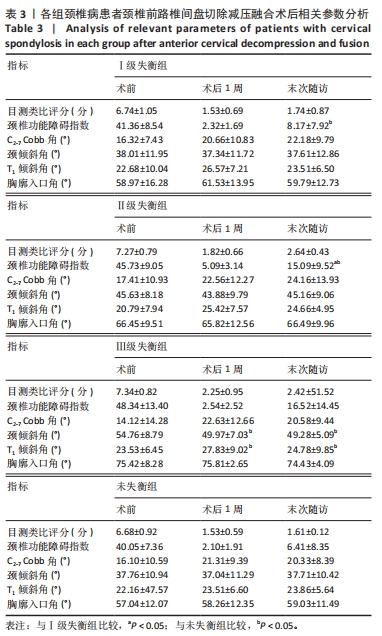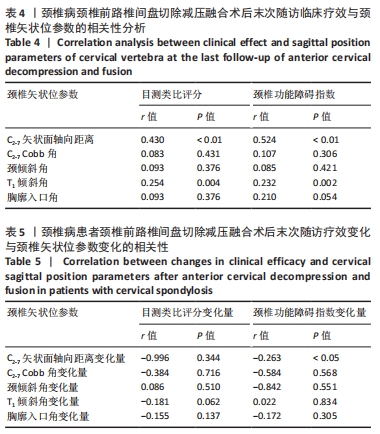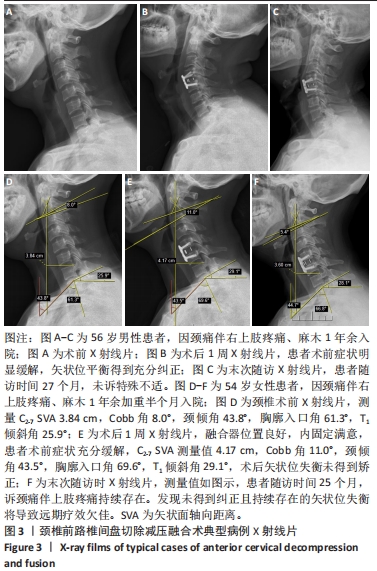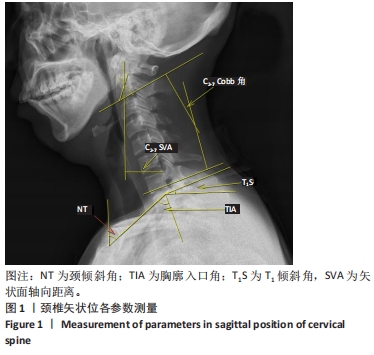[1] SUN YQ, ZHENG S, YU J, et al. Effect of total disc replacement on atypical symptoms associated with cervical spondylosis. Eur Spine J. 2013;22(7): 1553-1557.
[2] YANG L, LI Y, DAI C, et al. Anterior cervical decompression and fusion surgery for cervicogenic headache: A multicenter prospective cohort study. Front Neurol. 2022;13:1064976.
[3] HERMANSEN A, HEDLUND R, ZSIGMOND P, et al. A more than 20-year follow-up of pain and disability after anterior cervical decompression and fusion surgery for degenerative disc disease and comparisons between two surgical techniques. BMC Musculoskelet Disord. 2023; 24(1):406.
[4] ZHU J, FENG D, SONG D, et al. Effect of Anterior Cervical Decompression Fusion and Partial Resection of Uncinate Vertebra Joint on Cervical Sagittal Sequence in Patients with Non-Single-Segment Radiculopathy and its Correlation with Curative Effect: A Retrospective Analysis. Orthop Surg. 2023;15(4):1085-1095.
[5] HARTMANN S, KAVAKEBI P, WIPPLINGER C, et al. Retrospective analysis of cervical corpectomies: implant-related complications of one- and two-level corpectomies in 45 patients. Neurosurg Rev. 2018;41(1):285-290.
[6] FEHLINGS MG, GRAY R. Importance of sagittal balance in determining the outcome of anterior versus posterior surgery for cervical spondylotic myelopathy. J NEUROSURG-SPINE.2009;11(5):518-519; discussion.519-520.
[7] NICHOLSON KJ, MILLHOUSE PW, PFLUG E, et al. Cervical Sagittal Range of Motion as a Predictor of Symptom Severity in Cervical Spondylotic Myelopathy. Spine. 2018;43(13):883-889.
[8] WEI Z, ZHANG Y, YANG S, et al. Retrospective Analysis of Sagittal Balance Parameters and Clinical Efficacy After Short-Segment Anterior Cervical Spine Surgery with Different Fusion Devices. Int J Gen Med. 2022;15:3237-3246.
[9] PEREZ EA, WOODROFFE RW, PARK B, et al. Cervical alignment in the obese population following posterior cervical fusion for cervical myelopathy. Clin neurol neurosur. 2022;212(null):107059.
[10] THEODORE N. Degenerative Cervical Spondylosis. N Engl J Med. 2020; 383(2):159-168.
[11] NIU XP, ZHU WH, WANG L, et al. Assessment of the correlation between clinical and radiological outcomes in patients suffering from mild to moderate cervical spine dysfunction symptoms: a prospective study. J Orthop Surg Res. 2022;17(1):559.
[12] OE S, TOGAWA D, NAKAI K, et al. The Influence of Age and Sex on Cervical Spinal Alignment Among Volunteers Aged Over 50. Spine. 2015; 40(19):1487-1494.
[13] 唐彦超,赵文奎,于淼,等.无症状中国年轻人颈椎矢状位曲度正常值及其与全脊柱平衡的关系[J].北京大学学报(医学版),2022, 54(4):712-718.
[14] 赵文奎,于淼,韦峰,等.无症状成人颈椎矢状位曲度分析及其与全脊柱矢状位参数的关系[J].中国脊柱脊髓杂志,2015,25(3):231-238.
[15] WU L, LI YB, ZUO Y, et al. Study on the Biomimetic Properties of Bone Substitute Material: Nanohydroxyapatite/Polyamide 66 Composite. Materials Science Forum. 2006;510-511:938-941
[16] PARK MS, KELLY MP, LEE DH, et al. Sagittal alignment as a predictor of clinical adjacent segment pathology requiring surgery after anterior cervical arthrodesis. Spine J. 2014;14(7):1228-1234.
[17] XU C, SHEN Q, XU J, et al. Comparison of Cervical Sagittal Parameters Between Radiographs and Magnetic Resonance Images in Patients With Cervical Spondylotic Myelopathy. Global Spine J. 2021: 21925682211062498.
[18] OYEKAN AA, LEVASSEUR CM, SHAW JD, et al Changes in intervertebral sagittal alignment of the cervical spine from supine to upright. J Orthop Res. 2023;41(7):1538-1545.
[19] JANG JS, LEE SH, MIN JH, et al. Surgical treatment of failed back surgery syndrome due to sagittal imbalance. Spine. 2007;32(26):3081-3087.
[20] 胡伟,郑军,李成真. 前路椎间盘切除减压融合固定治疗两节段脊髓型颈椎病[J]. 临床骨科杂志,2019,22(1):5-8.
[21] 钱明权,顾羊林,曾柯,等.颈前路椎间盘切除融合术与颈后路椎板切除减压术治疗多节段脊髓型颈椎病的对比研究[J].中华骨与关节外科杂志,2016,9(5):376-380.
[22] SAKAI K, YOSHII T, HIRAI T, et al. Impact of the surgical treatment for degenerative cervical myelopathy on the preoperative cervical sagittal balance: a review of prospective comparative cohort between anterior decompression with fusion and laminoplasty. Eur Spine J. 2017;26(1): 104-112.
[23] ROGUSKI M, BENZEL EC, CURRAN JN, et al. Postoperative cervical sagittal imbalance negatively affects outcomes after surgery for cervical spondylotic myelopathy. Spine (Phila Pa 1976). 2014;39(25):2070-2077.
[24] SMITH JS, LAFAGE V, RYAN DJ, et al. Association of myelopathy scores with cervical sagittal balance and normalized spinal cord volume: analysis of 56 preoperative cases from the AOSpine North America Myelopathy study. Spine (Phila Pa 1976). 2013;38(22 Suppl 1): S161-S170.
[25] GLASSMAN SD, BRIDWELL K, DIMAR JR, et al. The impact of positive sagittal balance in adult spinal deformity. Spine. 2005;30(18):2024-2029.
[26] MA Z, LIU P, LIU J, et al. Kinematic analysis of the relationship between Modic changes and sagittal balance parameters in the cervical spine. Medicine (Baltimore). 2017;96(33):e7699.
[27] YANG BS, LEE SK, SONG KS, et al. The Use of T1 Sagittal Angle in Predicting Cervical Disc Degeneration. Asian Spine J. 2015;9(5):757-761.
[28] KNOTT PT, MARDJETKO SM, TECHY F. The use of the T1 sagittal angle in predicting overall sagittal balance of the spine. Spine J. 2010;10(11): 994-998.
[29] LE HUEC JC, SADDIKI R, FRANKE J, et al. Equilibrium of the human body and the gravity line: the basics. Eur Spine J. 2011;20 Suppl 5(Suppl 5): 558-563.
[30] TAMAI K, ROMANU J, GRISDELA P JR, et al. Small C7-T1 lordotic angle and muscle degeneration at C7 level were independent radiological characteristics of patients with cervical imbalance: a propensity score-matched analysis. Spine J. 2018;18(9):1505-1512.
[31] LI XY, WANG Y, ZHU WG, et al. Impact of cervical and global spine sagittal alignment on cervical curvature changes after posterior cervical laminoplasty. J Orthop Surg Res. 2022;17(1):521. |
